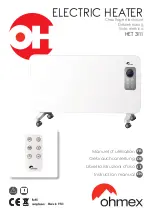
33
RESCUE OPERATIONS
Vehicle Fires
In cases of fire, the entire vehicle should be considered as energized. Toxic vapors can be released
from a heated or burning battery. To prevent personal injury, responders should always wear full
PPE, including a SCBA. Use proper measures to protect anyone downwind of the incident.
Firefighting
•
Deluge the vehicle continuously with water to extinguish the fire and cool the high-voltage battery.
•
Large amounts of water should be applied at the first signs of smoke from the battery. Water may absorb some of
the harmful emissions in the smoke.
•
If the vehicle is connected to an external power source (e.g. charging station or wall outlet) via a charge cable,
disable the power source BEFORE attempting to disconnect the cable. See
“Disconnecting the Charge Cable”,
•
For smaller fires that do not involve the high-voltage battery, normal vehicle firefighting procedures can be used.
Overhaul
•
Due to risk of re-ignition, the battery should be thermally assessed throughout rescue and overhaul procedures.
•
Before releasing the vehicle, the battery should be completely cooled with no smoke or heating present for at least
one hour.
•
All second responders and anyone coming in contact with the vehicle afterwards should be notified that the vehicle
contains a high-voltage system. Inform them of the risk of re-ignition.
Submerged Vehicles
The extent of any damages may not be apparent on submerged vehicles. Handling a submerged
vehicle without wearing appropriate PPE can result in serious injury or death.
•
To avoid electric shock, NEVER touch any of the high-voltage components on a submerged vehicle. See
“High-Voltage Components”, page 12
.
•
If the vehicle is connected to an external power source (e.g. charging station or wall outlet) via a charge cable,
disable the power source BEFORE attempting to disconnect the cable. See
“Disconnecting the Charge Cable”,
•
Drain the vehicle of water completely before attempting to disable the power. See
WARNING
WARNING
Summary of Contents for SOLO
Page 1: ...EMERGENCY RESPONDERS GUIDE ...
Page 2: ......
Page 44: ...42 STORAGE AND ISOLATION ...
Page 45: ......












































